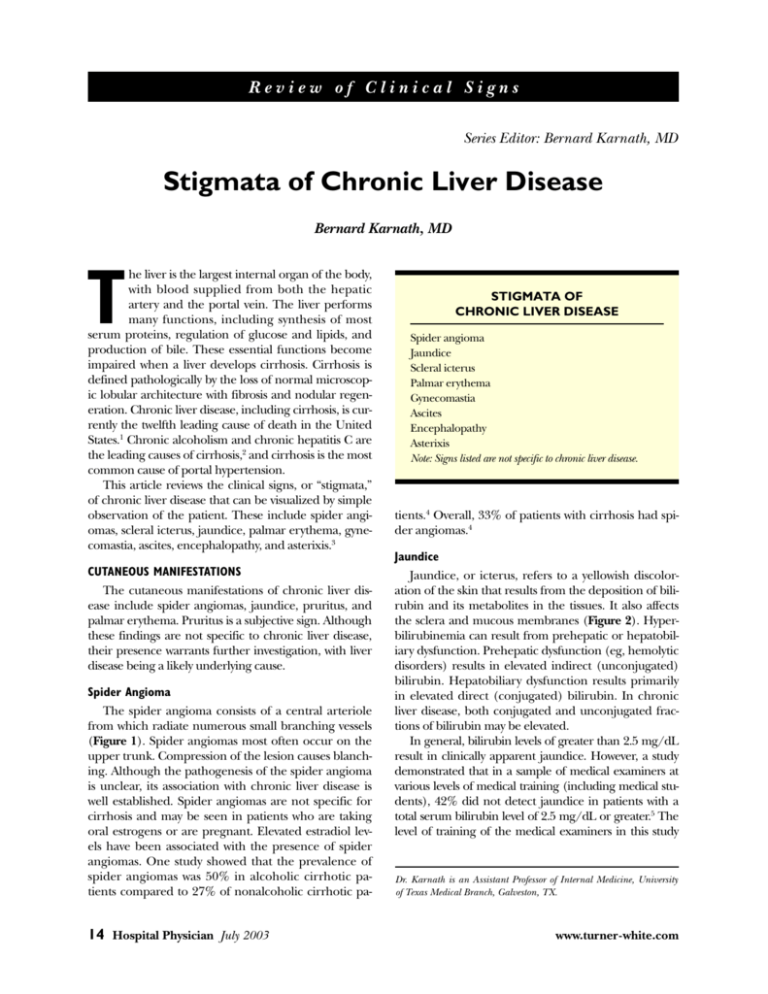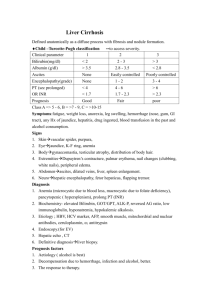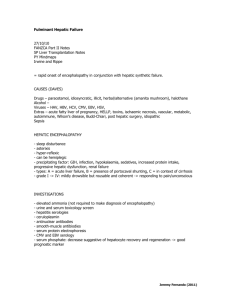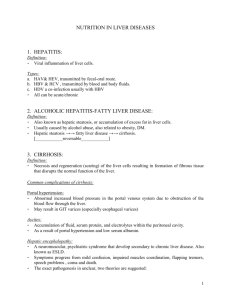
Review of Clinical Signs
Series Editor: Bernard Karnath, MD
Stigmata of Chronic Liver Disease
Bernard Karnath, MD
he liver is the largest internal organ of the body,
with blood supplied from both the hepatic
artery and the portal vein. The liver performs
many functions, including synthesis of most
serum proteins, regulation of glucose and lipids, and
production of bile. These essential functions become
impaired when a liver develops cirrhosis. Cirrhosis is
defined pathologically by the loss of normal microscopic lobular architecture with fibrosis and nodular regeneration. Chronic liver disease, including cirrhosis, is currently the twelfth leading cause of death in the United
States.1 Chronic alcoholism and chronic hepatitis C are
the leading causes of cirrhosis,2 and cirrhosis is the most
common cause of portal hypertension.
This article reviews the clinical signs, or “stigmata,”
of chronic liver disease that can be visualized by simple
observation of the patient. These include spider angiomas, scleral icterus, jaundice, palmar erythema, gynecomastia, ascites, encephalopathy, and asterixis.3
T
CUTANEOUS MANIFESTATIONS
The cutaneous manifestations of chronic liver disease include spider angiomas, jaundice, pruritus, and
palmar erythema. Pruritus is a subjective sign. Although
these findings are not specific to chronic liver disease,
their presence warrants further investigation, with liver
disease being a likely underlying cause.
Spider Angioma
The spider angioma consists of a central arteriole
from which radiate numerous small branching vessels
(Figure 1). Spider angiomas most often occur on the
upper trunk. Compression of the lesion causes blanching. Although the pathogenesis of the spider angioma
is unclear, its association with chronic liver disease is
well established. Spider angiomas are not specific for
cirrhosis and may be seen in patients who are taking
oral estrogens or are pregnant. Elevated estradiol levels have been associated with the presence of spider
angiomas. One study showed that the prevalence of
spider angiomas was 50% in alcoholic cirrhotic patients compared to 27% of nonalcoholic cirrhotic pa-
14 Hospital Physician July 2003
STIGMATA OF
CHRONIC LIVER DISEASE
Spider angioma
Jaundice
Scleral icterus
Palmar erythema
Gynecomastia
Ascites
Encephalopathy
Asterixis
Note: Signs listed are not specific to chronic liver disease.
tients.4 Overall, 33% of patients with cirrhosis had spider angiomas.4
Jaundice
Jaundice, or icterus, refers to a yellowish discoloration of the skin that results from the deposition of bilirubin and its metabolites in the tissues. It also affects
the sclera and mucous membranes (Figure 2). Hyperbilirubinemia can result from prehepatic or hepatobiliary dysfunction. Prehepatic dysfunction (eg, hemolytic
disorders) results in elevated indirect (unconjugated)
bilirubin. Hepatobiliary dysfunction results primarily
in elevated direct (conjugated) bilirubin. In chronic
liver disease, both conjugated and unconjugated fractions of bilirubin may be elevated.
In general, bilirubin levels of greater than 2.5 mg/dL
result in clinically apparent jaundice. However, a study
demonstrated that in a sample of medical examiners at
various levels of medical training (including medical students), 42% did not detect jaundice in patients with a
total serum bilirubin level of 2.5 mg/dL or greater.5 The
level of training of the medical examiners in this study
Dr. Karnath is an Assistant Professor of Internal Medicine, University
of Texas Medical Branch, Galveston, TX.
www.turner-white.com
Karnath : Stigmata of Chronic Liver Disease : pp. 14 – 16, 28
Figure 2. Scleral icterus.
Figure 1. Spider angioma.
affected the specificity but not the sensitivity in the detection of jaundice—that is, medical students had a higher
rate of false positives than did other examiners.
Patients with jaundice from liver disease also frequently report a darkening of the urine, which is a sign
of elevated conjugated bilirubin. Jaundice without
darkened urine indicates elevated unconjugated bilirubin.6 This is because unconjugated bilirubin binds to
albumin in the serum and is not filtered by the kidney.
Other Cutaneous Manifestations
Pruritus is a common complaint in patients with
chronic liver disease. Although bile acids have received
the most attention as a possible cause,7,8 the pathogenesis of itching in these patients is still not clear. Patients
with pruritus from cholestasis typically describe itching
of the palms of the hands and soles of the feet, although diffuse pruritus is common and excoriation
may be evident.
Another cutaneous finding that may be present in
chronic liver disease is palmar erythema, although it is
not specific for liver disease. Palmar erythema may appear as mottling of the palms or as a blanching erythematous patch.
Portal hypertension leads to the development of
portosystemic collateral channels. Abdominal wall collateral veins appear as tortuous vessels that radiate
from the umbilicus, the so-called caput medusae, another clinical sign of chronic liver disease.
nomenon or a sign of an underlying disease.9,10 The
prevalence of gynecomastia in cirrhotic patients was
reported in one study to be 44%.10 True gynecomastia
is characterized by palpable glandular tissue, especially
around the areola. Lipomastia is breast tissue enlargement from adipose tissue and is not a pathologic finding.
Pathologic gynecomastia can result from deficiency
in testosterone activity or from increased estrogen levels. Gynecomastia in chronic liver disease is caused by
diminished catabolism of androstenedione, thereby
shunting estrogen precursors and increasing plasma
levels of estradiol.9 The resultant elevation in the ratio
of free estradiol to free testosterone causes feminization. Additionally, many cirrhotic patients take spironolactone, which is an inhibitor of testosterone synthesis.
GYNECOMASTIA
Gynecomastia is the enlargement of the male breast
(Figure 3). It can either be a normal physiologic phe-
ASCITES
Ascites can result from portal hypertension, and cirrhosis accounts for up to 80% of cases of ascites.11
www.turner-white.com
Figure 3. Gynecomastia.
Hospital Physician July 2003
15
Karnath : Stigmata of Chronic Liver Disease : pp. 14 – 16, 28
Table 1. Physical Examination Findings to Detect Ascites
Finding
Bulging flanks
Sensitivity
Specificity
0.78
0.44
Flank dullness
0.94
0.56
Shifting dullness
0.83
0.56
Fluid wave
0.50
0.82
Puddle sign
0.51
0.51
Reprinted from Cattau EL Jr, Benjamin SB, Knuff TE, Castell DO. The
accuracy of the physical examination in the diagnosis of suspected
ascites. JAMA 1982;247:1165.
Figure 4. Tense ascites.
Tympany
Dullness
Tympany
Dullness
Figure 5. Elicitation of shifting dullness. (top) Supine position.
(bottom) Lateral decubitus position.
Ascites is not specific to liver disease; other causes of
ascites include cancer, heart failure, and the nephrotic
syndrome. Severe, or tense, ascites is shown in Figure 4.
The physical examination maneuvers used to detect
ascites include assessing for bulging flanks, flank dullness, shifting dullness, a fluid wave, and a puddle sign.
All of these maneuvers are performed with the patient
in a supine position, with the exception of the puddle
sign. Bulging flanks and flank dullness are considered
present only if bulging and dullness to percussion are
bilateral. To test for shifting dullness, the patient
should be instructed to roll from the supine position to
the lateral decubitus position on both the left and the
right sides (Figure 5). Percussion of the abdomen is
performed in both positions. In the supine position,
tympany is noted in the periumbilical region as the
accumulated fluid is displaced to the flanks, where
dullness to percussion is noted. With the patient in the
lateral decubitus position, the area of tympany shifts
upward, hence the term shifting dullness.
A fluid wave can be demonstrated by percussing on
one side of the abdomen while palpating the other side
of the abdomen with the palm of the opposite hand. The
puddle sign is elicited by asking the patient to assume a
position on the knees and elbows. The umbilical area is
percussed for dullness, which is a sign of fluid pooling.
The sensitivity and specificity of each of these physical
examination maneuvers are presented in Table 1. Although flank dullness is the most sensitive maneuver in
detecting ascites, it is not very specific. The detection of a
fluid wave is the most specific maneuver.
ENCEPHALOPATHY
Hepatic encephalopathy is a neuropsychiatric complication of chronic liver disease. It is defined as a disturbance in central nervous function due to hepatic insufficiency and is characterized by a change in personality,
impaired intellect, and a depressed level of consciousness.12 Hyperammonemia is common in chronic liver
disease and may have a role in the development of
hepatic encephalopathy. Ammonia is a degradation
product of intestinal flora and has neurotoxic effects.
(continued on page 28)
16 Hospital Physician July 2003
www.turner-white.com
Karnath : Stigmata of Chronic Liver Disease : pp. 14 – 16, 28
(from page 16)
Plasma ammonia levels are usually elevated in
patients with hepatic encephalopathy, although levels
may be normal in up to 10% of patients with hepatic encephalopathy.13 The grading of hepatic encephalopathy
is shown in Table 2.
Table 2. Grading of Hepatic Encephalopathy
ASTERIXIS
Asterixis (flapping tremor) is described as a jerky
rhythmical tremor. It is a negative myoclonus caused by
brief pauses in muscle activity. Asterixis is best demonstrated by having the patient extend the arms and dorsiflex the hands. Asterixis is not specific to chronic liver
disease and can be seen in other metabolic disorders,
such as renal failure, hyponatremia, hypoglycemia and
nonketotic hyperglycemia.14 The relationship between
asterixis and hyperammonemia has been established.
CONCLUSION
Many signs of chronic liver disease can be detected
by simple observation. Although many of these signs
are not specific for liver disease, their presence, particularly in patients with risk factors or other indicators of
liver disease, often warrants a work-up that includes
hepatic studies.
HP
Grade
Description
0
Normal mental status. Asterixis absent.
1
Mild confusion. Asterixis can be detected.
2
Lethargy with inappropriate behavior. Obvious
asterixis.
3
Somnolent with incomprehensible speech and
marked confusion
4
Coma
Adapted with permission from Blei AT, Cordoba J. Hepatic encephalopathy. Practice Parameters of the American College of Gastroenterology. Am J Gastroenterol 2001;96:1969.
6.
7.
8.
9.
REFERENCES
1. Minino AM, Smith BL. Deaths: preliminary data for 2000.
Natl Vital Stat Rep 2001;49:1–40.
2. Degos F. Hepatitis C and alcohol. J Hepatol 1999;31
Suppl 1:113–8.
3. Diehl AM. Alcoholic liver disease. Med Clin North Am
1989;73:815–30.
4. Li CP, Lee FY, Hwang SJ, et al. Spider angiomas in patients with liver cirrhosis: role of alcoholism and impaired liver function. Scand J Gastroenterol 1999;34:
520–3.
5. Ruiz MA, Saab S, Rickman LS. The clinical detection of
10.
11.
12.
13.
14.
scleral icterus: observations of multiple examiners. Mil
Med 1997;162:560–3.
Hass PL. Differentiation and diagnosis of jaundice.
AACN Clin Issues 1999;10:433–41.
Berman JE, Lamkin BC. Hepatic disease and the skin.
Dermatol Clin 1989;7:435–48.
Garden JM, Ostrow JD, Roenigk HH Jr. Pruritis in hepatic cholestasis. Pathogenesis and therapy. Arch Dermatol
1985;121:1415–20.
Braunstein GD. Gynecomastia. N Engl J Med 1993;328:
490–5.
Cavanaugh J, Niewoehner CB, Nuttall FQ. Gynecomastia and cirrhosis of the liver. Arch Intern Med 1990;150:
563–5.
Runyon BA. Care of patients with ascites. N Engl J Med
1994;330:337–42.
Butterworth RF. Complications of cirrhosis III. Hepatic
encephalopathy. J Hepatol 2000;32 Suppl 1:171–80.
Weissenborn K. Diagnosis of encephalopathy. Digestion
1998;59 Suppl 2:22–4.
Blindauer K. Myoclonus and its disorders. Neurol Clin
2001;19:723–34.
Copyright 2003 by Turner White Communications Inc., Wayne, PA. All rights reserved.
28 Hospital Physician July 2003
www.turner-white.com







